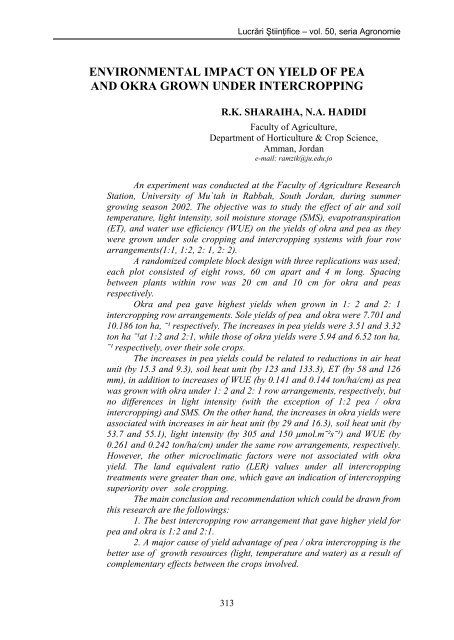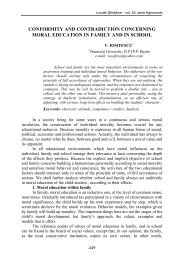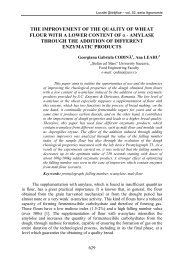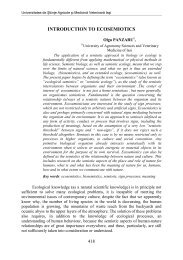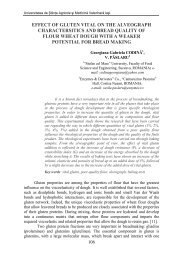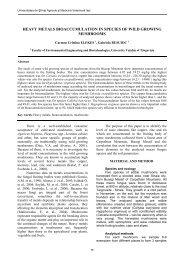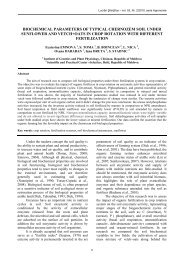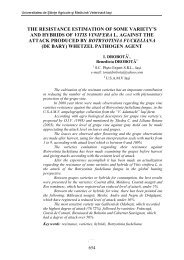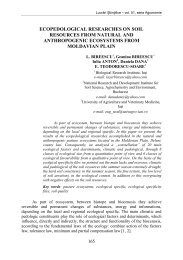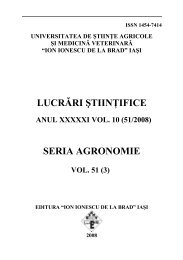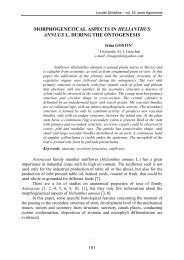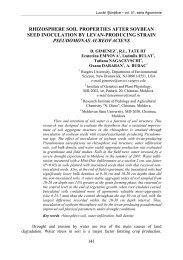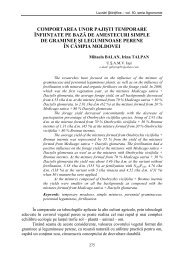environmental impact on yield of pea and okra grown under ...
environmental impact on yield of pea and okra grown under ...
environmental impact on yield of pea and okra grown under ...
You also want an ePaper? Increase the reach of your titles
YUMPU automatically turns print PDFs into web optimized ePapers that Google loves.
Lucrări Ştiinţifice – vol. 50, seria Agr<strong>on</strong>omie<br />
ENVIRONMENTAL IMPACT ON YIELD OF PEA<br />
AND OKRA GROWN UNDER INTERCROPPING<br />
R.K. SHARAIHA, N.A. HADIDI<br />
Faculty <strong>of</strong> Agriculture,<br />
Department <strong>of</strong> Horticulture & Crop Science,<br />
Amman, Jordan<br />
e-mail: ramzik@ju.edu.jo<br />
An experiment was c<strong>on</strong>ducted at the Faculty <strong>of</strong> Agriculture Research<br />
Stati<strong>on</strong>, University <strong>of</strong> Mu`tah in Rabbah, South Jordan, during summer<br />
growing seas<strong>on</strong> 2002. The objective was to study the effect <strong>of</strong> air <strong>and</strong> soil<br />
temperature, light intensity, soil moisture storage (SMS), evapotranspirati<strong>on</strong><br />
(ET), <strong>and</strong> water use efficiency (WUE) <strong>on</strong> the <strong>yield</strong>s <strong>of</strong> <strong>okra</strong> <strong>and</strong> <strong>pea</strong> as they<br />
were <strong>grown</strong> <strong>under</strong> sole cropping <strong>and</strong> intercropping systems with four row<br />
arrangements(1:1, 1:2, 2: 1, 2: 2).<br />
A r<strong>and</strong>omized complete block design with three replicati<strong>on</strong>s was used;<br />
each plot c<strong>on</strong>sisted <strong>of</strong> eight rows, 60 cm apart <strong>and</strong> 4 m l<strong>on</strong>g. Spacing<br />
between plants within row was 20 cm <strong>and</strong> 10 cm for <strong>okra</strong> <strong>and</strong> <strong>pea</strong>s<br />
respectively.<br />
Okra <strong>and</strong> <strong>pea</strong> gave highest <strong>yield</strong>s when <strong>grown</strong> in 1: 2 <strong>and</strong> 2: 1<br />
intercropping row arrangements. Sole <strong>yield</strong>s <strong>of</strong> <strong>pea</strong> <strong>and</strong> <strong>okra</strong> were 7.701 <strong>and</strong><br />
10.186 t<strong>on</strong> ha, ¯¹ respectively. The increases in <strong>pea</strong> <strong>yield</strong>s were 3.51 <strong>and</strong> 3.32<br />
t<strong>on</strong> ha ¯¹at 1:2 <strong>and</strong> 2:1, while those <strong>of</strong> <strong>okra</strong> <strong>yield</strong>s were 5.94 <strong>and</strong> 6.52 t<strong>on</strong> ha,<br />
¯¹ respectively, over their sole crops.<br />
The increases in <strong>pea</strong> <strong>yield</strong>s could be related to reducti<strong>on</strong>s in air heat<br />
unit (by 15.3 <strong>and</strong> 9.3), soil heat unit (by 123 <strong>and</strong> 133.3), ET (by 58 <strong>and</strong> 126<br />
mm), in additi<strong>on</strong> to increases <strong>of</strong> WUE (by 0.141 <strong>and</strong> 0.144 t<strong>on</strong>/ha/cm) as <strong>pea</strong><br />
was <strong>grown</strong> with <strong>okra</strong> <strong>under</strong> 1: 2 <strong>and</strong> 2: 1 row arrangements, respectively, but<br />
no differences in light intensity (with the excepti<strong>on</strong> <strong>of</strong> 1:2 <strong>pea</strong> / <strong>okra</strong><br />
intercropping) <strong>and</strong> SMS. On the other h<strong>and</strong>, the increases in <strong>okra</strong> <strong>yield</strong>s were<br />
associated with increases in air heat unit (by 29 <strong>and</strong> 16.3), soil heat unit (by<br />
53.7 <strong>and</strong> 55.1), light intensity (by 305 <strong>and</strong> 150 µmol.m¯²s¯¹) <strong>and</strong> WUE (by<br />
0.261 <strong>and</strong> 0.242 t<strong>on</strong>/ha/cm) <strong>under</strong> the same row arrangements, respectively.<br />
However, the other microclimatic factors were not associated with <strong>okra</strong><br />
<strong>yield</strong>. The l<strong>and</strong> equivalent ratio (LER) values <strong>under</strong> all intercropping<br />
treatments were greater than <strong>on</strong>e, which gave an indicati<strong>on</strong> <strong>of</strong> intercropping<br />
superiority over sole cropping.<br />
The main c<strong>on</strong>clusi<strong>on</strong> <strong>and</strong> recommendati<strong>on</strong> which could be drawn from<br />
this research are the followings:<br />
1. The best intercropping row arrangement that gave higher <strong>yield</strong> for<br />
<strong>pea</strong> <strong>and</strong> <strong>okra</strong> is 1:2 <strong>and</strong> 2:1.<br />
2. A major cause <strong>of</strong> <strong>yield</strong> advantage <strong>of</strong> <strong>pea</strong> / <strong>okra</strong> intercropping is the<br />
better use <strong>of</strong> growth resources (light, temperature <strong>and</strong> water) as a result <strong>of</strong><br />
complementary effects between the crops involved.<br />
313
Universitatea de Ştiinţe Agricole şi Medicină Veterinară Iaşi<br />
3. Temporal complementarily produced more advantage than spatial<br />
complementarily, but this needs further investigati<strong>on</strong>.<br />
Keywords: <strong>pea</strong>, <strong>okra</strong>, intercropping, row arrangement, <strong>yield</strong>.<br />
Research <strong>on</strong> intercropping system (planting two or more crops <strong>on</strong> the same<br />
piece <strong>of</strong> l<strong>and</strong> at the same time or during part <strong>of</strong> the life cycle <strong>of</strong> each) is becoming<br />
very comm<strong>on</strong> in Jordan as well as in other countries. There are several reas<strong>on</strong>s<br />
encouraging small farmers to adopt intercropping system, which include stability<br />
<strong>of</strong> <strong>yield</strong>; a better variety <strong>of</strong> returns from l<strong>and</strong> <strong>and</strong> labor; increased efficiency <strong>of</strong><br />
scarce resources utilizati<strong>on</strong>; <strong>and</strong> reduce the risk <strong>of</strong> dependence up<strong>on</strong> a sole crop<br />
that is susceptible to <str<strong>on</strong>g>envir<strong>on</strong>mental</str<strong>on</strong>g> <strong>and</strong> ec<strong>on</strong>omic fluctuati<strong>on</strong>s. It was indicated<br />
that light use efficiency could be an important factor for the <strong>yield</strong> advantages <strong>under</strong><br />
intercropping system such as millet with groundnut (Radke <strong>and</strong> Hagstrom, 1976)<br />
<strong>and</strong> potato with corn intercropping (Sharaiha <strong>and</strong> Battikhi, 2002). Elsayed <strong>and</strong><br />
K<strong>and</strong>eel (2003) showed that low density <strong>of</strong> trees, (Casurina glauca <strong>and</strong> Eucalyptus<br />
camaldulensis), modify the microclimate for <strong>okra</strong>, cow<strong>pea</strong>s <strong>and</strong> squash <strong>and</strong> <strong>of</strong>fers a<br />
beneficial effect <strong>on</strong> their physiological processes. Kuruppuarachchi, (1990) found<br />
that the benefit <strong>of</strong> shading <strong>on</strong> intercropped potato <strong>yield</strong>s was variable <strong>and</strong> this<br />
variability might be related to the degree <strong>of</strong> shading. Batugal et al. (1990) reported<br />
that intercropping maize with potato could be beneficial in providing partial shade<br />
for potato <strong>and</strong> reduce both air <strong>and</strong> soil temperatures. Sharaiha <strong>and</strong> Klus<strong>on</strong> (1994)<br />
reported that both soil <strong>and</strong> air temperatures required for faba bean nitrogen fixati<strong>on</strong><br />
were significantly higher when it was planted with <strong>pea</strong> as compared with faba bean<br />
sole crop. Al-Qahwaji, (1994) pointed out that evapotranspirati<strong>on</strong> for potato <strong>and</strong><br />
faba bean <strong>under</strong> intercropping was less than that <strong>of</strong> sole cropping, while water use<br />
efficiency was significantly higher <strong>under</strong> intercropping than <strong>under</strong> sole cropping.<br />
Midmore, (1990) found that the higher <strong>yield</strong>s <strong>of</strong> corn intercropped with potato<br />
were due to the higher amount <strong>of</strong> soil moisture storage caused by a decrease in<br />
dem<strong>and</strong> <strong>of</strong> water after potato maturity. Natrajan <strong>and</strong> Willey (1980) indicated that<br />
intercropping might give relative advantages <strong>under</strong> c<strong>on</strong>diti<strong>on</strong>s <strong>of</strong> moisture stress<br />
but little or n<strong>on</strong>e <strong>under</strong> no stress c<strong>on</strong>diti<strong>on</strong>s. Yet, exactly the opposite results were<br />
found by Lakhani (1976), cited by Willey (1979), when fodder radish / sunflower<br />
were c<strong>on</strong>sidered. Sharaiha <strong>and</strong> Battikhi, (2002) showed that the effect <strong>of</strong><br />
temperature, light intercepti<strong>on</strong>, soil moisture storage, evapotranspirati<strong>on</strong>, <strong>and</strong> water<br />
use efficiency <strong>under</strong> intercropping system were varied according to crop<br />
combinati<strong>on</strong> <strong>and</strong> row arrangements within a combinati<strong>on</strong>. Since the<br />
micro<str<strong>on</strong>g>envir<strong>on</strong>mental</str<strong>on</strong>g> factors depends <strong>on</strong> intercropping combinati<strong>on</strong>s <strong>and</strong> row<br />
arrangements, more work <strong>of</strong> this nature is needed to provide more informati<strong>on</strong> in<br />
order to improve the intercropping system. Therefore, the objective <strong>of</strong> this<br />
experiment is to study the effect <strong>of</strong> <strong>okra</strong> / <strong>pea</strong> intercropping <strong>on</strong> the following<br />
ecological parameters: -Air <strong>and</strong> soil temperatures; light intercepti<strong>on</strong>; soil moisture<br />
storage; evapotranspirati<strong>on</strong>; water use efficiency; <strong>and</strong> c<strong>on</strong>sequently <strong>on</strong> the <strong>yield</strong> <strong>of</strong><br />
<strong>okra</strong> <strong>and</strong> <strong>pea</strong>.<br />
314
Lucrări Ştiinţifice – vol. 50, seria Agr<strong>on</strong>omie<br />
MATERIALS AND METHODS<br />
A field experiment was c<strong>on</strong>ducted in 2002, summer growing seas<strong>on</strong> at the<br />
University <strong>of</strong> Mutah, Faculty <strong>of</strong> Agriculture Field Stati<strong>on</strong>, in Rabbah, (31.2º N, 35.5º E,<br />
altitude 920 meter above the sea level, 120 km. South <strong>of</strong> Amman). The soil texture is<br />
clay loam, the climate is semi-arid with mean annual precipitati<strong>on</strong> <strong>of</strong> 326 mm <strong>and</strong> mean<br />
annual temperature <strong>of</strong> 16.2ºC. Okra (variety C-Spineless) <strong>and</strong> <strong>pea</strong> (variety Red Thiram)<br />
were planted during summer growing seas<strong>on</strong> 2002 (March 31) <strong>under</strong> intercropping<br />
system with four row arrangements, (1:1; 1:2; 2:1; <strong>and</strong> 2:2;) in additi<strong>on</strong> to their sole<br />
crops. Composed poultry manure was applied before planting at the rate <strong>of</strong> 15Mt. ha ¯¹.<br />
A r<strong>and</strong>omized complete block design with three replicati<strong>on</strong>s was used; each plot<br />
c<strong>on</strong>sisted <strong>of</strong> eight rows, 60 cm apart <strong>and</strong> 4 meters l<strong>on</strong>g. Spacing between plants within<br />
row was 20 cm <strong>and</strong> 10 cm for <strong>okra</strong> <strong>and</strong> <strong>pea</strong>, respectively. Weeds were kept <strong>under</strong><br />
c<strong>on</strong>trol manually. Surface lateral pipes <strong>of</strong> 16mm diameter were installed <strong>on</strong> every<br />
planting row in order to deliver water to plants. In line, drippers with 40 cm spacing <strong>and</strong><br />
4 liters per hour per dripper discharge rate were used for irrigati<strong>on</strong>. The amount <strong>of</strong><br />
water added was recorded by water meter. Soil moisture measurements were taken at<br />
7.5, 22.5, 45 <strong>and</strong> 75 cm soil depth using neutr<strong>on</strong> probe. In additi<strong>on</strong>, gravimetric method<br />
was used to support neutr<strong>on</strong> probe readings for the first two layers. Two access tubes<br />
<strong>of</strong> 90 cm l<strong>on</strong>g <strong>and</strong> two inches diameter were installed within the row between two<br />
adjacent <strong>okra</strong> <strong>and</strong> <strong>pea</strong> plants <strong>under</strong> intercropping treatments, while <strong>on</strong>e access tube<br />
was installed for each sole crop. Calibrati<strong>on</strong> for different soil layers was correlated with<br />
soil moisture counts <strong>of</strong> neutr<strong>on</strong> probe with gravimetric soil moisture samples. Linear<br />
regressi<strong>on</strong> equati<strong>on</strong> for calibrati<strong>on</strong> <strong>of</strong> neutr<strong>on</strong> probe for the third layer was Pv%= 38.30<br />
CR – 15.23, <strong>and</strong> that for the fourth layer was Pv% =29.88CR – 15.23, where Pv% is a<br />
volumetric moisture c<strong>on</strong>tent <strong>and</strong> CR (count ratio) is a neutr<strong>on</strong> probe reading in the field.<br />
Crop evapotranspirati<strong>on</strong> (ET) <strong>and</strong> soil moisture storage (SMS) were calculated by using<br />
the following equati<strong>on</strong>s: - -ET= R+I+Dsi –DP. Where R: is the amount <strong>of</strong> rainfall <strong>and</strong> it<br />
was equal to zero. I: is the amount <strong>of</strong> irrigati<strong>on</strong>, Dsi: is the initial soil moisture c<strong>on</strong>tent<br />
<strong>and</strong> DP: is deep percolati<strong>on</strong> <strong>and</strong> it was equal to zero. -SMS= Σ [Increase in soil<br />
moisture (+∆s)] where ∆s is the difference between two neutr<strong>on</strong> probe readings for the<br />
soil moisture storage taken after irrigati<strong>on</strong> by 16 hours <strong>and</strong> before each irrigati<strong>on</strong>. While<br />
water use efficiency (WUE) was calculated by dividing <strong>yield</strong> over ET. Daily light <strong>and</strong><br />
temperature (air & soil) measurements (taken between 11 AM <strong>and</strong> 1 PM) started 24<br />
days after plant emergence using porometer <strong>and</strong> thermometer, respectively. However,<br />
soil <strong>and</strong> air temperatures were recorded as heat unit, using the 50 – 80F method<br />
(Battikhi <strong>and</strong> Ghawi, 1987). The heat unit method should indicate which <strong>of</strong> the<br />
treatments provided best temperature for plant growth. Light measurement was taken<br />
at lower, middle <strong>and</strong> the upper part <strong>of</strong> the stem (averages were calculated). Harvesting<br />
date started <strong>on</strong> May 16 <strong>and</strong> ended <strong>on</strong> July 31 for both crops. Yield for both crops were<br />
obtained from the middle three meters <strong>of</strong> the central four rows for 2:2 <strong>and</strong> 1:1 row<br />
combinati<strong>on</strong>s <strong>and</strong> from the middle <strong>of</strong> the central three rows, for 1:2 <strong>and</strong> 2:1 row<br />
combinati<strong>on</strong>s. The l<strong>and</strong> equivalent ratio (LER) was calculated for the combined<br />
intercropped <strong>yield</strong>s <strong>and</strong> for the intercrop <strong>yield</strong> <strong>of</strong> each crop, as described by Willey<br />
(1979), who expressed the intercrop <strong>yield</strong> <strong>on</strong> a relative basis to a sole crop <strong>yield</strong> (i.e.<br />
where LER = 1). Analysis <strong>of</strong> variance for the micro- envir<strong>on</strong>ment values <strong>and</strong> <strong>yield</strong> data<br />
were determined. The Duncan’s Multiple Range Test (DMRT) was then employed for<br />
mean separati<strong>on</strong>.<br />
315
Universitatea de Ştiinţe Agricole şi Medicină Veterinară Iaşi<br />
RESULTS AND DISCUSSION<br />
Effect <strong>of</strong> Intercropping Pea / Okra <strong>on</strong> Air <strong>and</strong> Soil Heat Units VS Pea<br />
Yield<br />
Average air <strong>and</strong> soil heat units for <strong>pea</strong> as it was <strong>grown</strong> <strong>under</strong> sole cropping<br />
<strong>and</strong> intercropping are presented in table 1A. It is clear that the variati<strong>on</strong>s in the<br />
values <strong>of</strong> soil heat unit <strong>under</strong> <strong>pea</strong> sole crop <strong>and</strong> <strong>pea</strong> intercropped with <strong>okra</strong> are<br />
more pr<strong>on</strong>ounced than those <strong>of</strong> the air heat unit, where a reducti<strong>on</strong> <strong>of</strong> soil heat unit<br />
<strong>under</strong> <strong>pea</strong> intercropping was ranged between 60-133.3 as compared to <strong>pea</strong> sole<br />
cropping, while for air heat unit the reducti<strong>on</strong> was ranged between 2.9-15.3.<br />
Batugal et. al (1990) explained the reducti<strong>on</strong> in soil temperature to be due to<br />
radiati<strong>on</strong> reflecti<strong>on</strong>, shading effect <strong>of</strong> the taller crop <strong>and</strong> water c<strong>on</strong>serving<br />
properties <strong>under</strong> intercropping system. However, in the present study, the water<br />
c<strong>on</strong>servati<strong>on</strong> has not been clearly dem<strong>on</strong>strated. Moreover, a significant reducti<strong>on</strong><br />
<strong>of</strong> air <strong>and</strong> soil heat unit was obtained when <strong>pea</strong> was planted with <strong>okra</strong> <strong>under</strong> 1: 2<br />
<strong>and</strong> 2: 1 row arrangements as compared to <strong>pea</strong> sole crop. Where soil heat unit<br />
gave a decrease <strong>of</strong> 133.3 <strong>and</strong> 123.0, respectively. While air heat unit gave a<br />
decrease <strong>of</strong> 15.3 <strong>and</strong> 9.3, respectively, compared to its sole crop. This could be<br />
explained by the shading development effect caused by <strong>okra</strong> plants. Moreover, the<br />
significant higher <strong>yield</strong>s <strong>of</strong> <strong>pea</strong> (Table3) were obtained <strong>under</strong> the same treatments<br />
(1:2 <strong>and</strong> 2:1), where the maximum reducti<strong>on</strong> <strong>of</strong> soil <strong>and</strong> air heat unit were<br />
recorded. Therefore, the shading development gave optimum values <strong>of</strong> soil <strong>and</strong><br />
heat unit that affected significantly <strong>yield</strong> <strong>of</strong> <strong>pea</strong> especially <strong>under</strong> hot dry summer<br />
c<strong>on</strong>diti<strong>on</strong>s. This agrees with the findings <strong>of</strong> Sharaiha <strong>and</strong> Battikhi (2002) <strong>on</strong> their<br />
work <strong>on</strong> potato / corn intercropping <strong>and</strong> with Batugal et al (1990) <strong>on</strong> their work <strong>on</strong><br />
potato / maize intercropping.<br />
Effect <strong>of</strong> Intercropping Pea / Okra <strong>on</strong> Light intercepti<strong>on</strong> VS Pea Yield<br />
Intercropping <strong>pea</strong> with <strong>okra</strong> <strong>under</strong> different row arrangements (1:1, 1:2, 2:1,<br />
<strong>and</strong> 2:2) resulted in a reducti<strong>on</strong> <strong>of</strong> light intercepti<strong>on</strong> as compared with <strong>pea</strong> sole crop<br />
(Table 1A). However, significant maximum reducti<strong>on</strong> was obtained <strong>under</strong> 1:2 <strong>pea</strong> /<br />
<strong>okra</strong> row arrangement, where it gave a decrease in light intercepti<strong>on</strong> <strong>of</strong> 110.6 µ mol<br />
m¯²s¯¹ as compared to the value obtained <strong>under</strong> <strong>pea</strong> sole crop. This could be<br />
attributed to the shading effect <strong>of</strong> <strong>okra</strong> plants <strong>on</strong> <strong>pea</strong>, since <strong>pea</strong> was planted<br />
between double rows <strong>of</strong> <strong>okra</strong> in each side. On the other h<strong>and</strong>, the highest<br />
significant <strong>yield</strong> <strong>of</strong> <strong>pea</strong> was obtained <strong>under</strong> the lowest value <strong>of</strong> light intercepti<strong>on</strong><br />
(1:2 <strong>pea</strong> / <strong>okra</strong> intercropping) where it gave an increase in <strong>yield</strong> <strong>of</strong> 45.6% over the<br />
<strong>yield</strong> <strong>of</strong> <strong>pea</strong> sole crop (Table3). However, the other intercropping treatments<br />
showed no significant differences in average light intercepti<strong>on</strong> compared to <strong>pea</strong><br />
sole crop, although <strong>yield</strong> <strong>of</strong> <strong>pea</strong> <strong>grown</strong> with <strong>okra</strong> in 2:1 row arrangement gave<br />
significant higher <strong>yield</strong> over its sole crop. Therefore, other factors might play an<br />
important role that affected positively the <strong>yield</strong> <strong>of</strong> <strong>pea</strong> as it was intercropped with<br />
<strong>okra</strong> in 2:1 row arrangement, such as evapotranspirati<strong>on</strong>, water use efficiency<br />
(Table 2A) air <strong>and</strong> soil heat unit (Table 1A) in additi<strong>on</strong> to the canopy development.<br />
316
Lucrări Ştiinţifice – vol. 50, seria Agr<strong>on</strong>omie<br />
This fact has been pointed out by Sharaiha <strong>and</strong> Haddad (1985) in their work <strong>on</strong><br />
potential <strong>of</strong> row intercropping <strong>of</strong> cabbage, broad bean <strong>and</strong> corn, <strong>and</strong> by Batugal et<br />
al. (1990) in their work <strong>on</strong> intercropping potato with maize in low l<strong>and</strong> Philippines.<br />
However, the differences in <strong>yield</strong> <strong>of</strong> <strong>pea</strong> <strong>grown</strong> with <strong>okra</strong> <strong>under</strong> different row<br />
arrangements were not significant (Table3). This could be an indicati<strong>on</strong> that light<br />
intercepti<strong>on</strong> for <strong>pea</strong> <strong>under</strong> intercropping row combinati<strong>on</strong>s were within range.<br />
Similar results were obtained by Harris (1990) in his study <strong>on</strong> “Crop radiati<strong>on</strong> use:<br />
A justificati<strong>on</strong> for intercropping.”<br />
Effect <strong>of</strong> Intercropping Pea / Okra <strong>on</strong> Soil Moisture Storage (SMS)<br />
Evapo-transpirati<strong>on</strong> (ET) <strong>and</strong> Water Use Efficiency (WUE) VS Pea Yield<br />
There is no significant effect <strong>on</strong> SMS from intercropping <strong>pea</strong> with <strong>okra</strong> as<br />
compared with <strong>pea</strong> sole crop (Table 2A). These results are c<strong>on</strong>tradicted to what it<br />
is expected, specially when <strong>pea</strong> was intercropped with <strong>okra</strong> <strong>under</strong> 1:2 <strong>and</strong> 2:1 row<br />
arrangement where the values <strong>of</strong> soil heat unit, air heat unit (Table 1A) <strong>and</strong> ET<br />
(Table 2A) were lower than <strong>under</strong> <strong>pea</strong> sole crop. Therefore, this could be attributed<br />
to the water extracti<strong>on</strong> <strong>of</strong> <strong>pea</strong> which might use the water from the upper part <strong>of</strong> root<br />
z<strong>on</strong>e <strong>on</strong>ly <strong>and</strong> that is due to its shallow fibrous root system, while <strong>okra</strong> might have<br />
extracted water from the whole root z<strong>on</strong>e, knowing that <strong>okra</strong> plants have deeper tap<br />
root system with wider root branches specially in the first 45cm (Shanan 1970).<br />
Thus competiti<strong>on</strong> for water especially at the upper part <strong>of</strong> the root z<strong>on</strong>e might exist,<br />
leading to maintain the level <strong>of</strong> SMS <strong>under</strong> intercropped <strong>pea</strong> un reduced. These<br />
results agree with the findings <strong>of</strong> Trenbath (1976) <strong>and</strong> c<strong>on</strong>tradict the findings <strong>of</strong><br />
Jeiming <strong>and</strong> Midmore (1990) <strong>and</strong> Midmore (1988), obviously due to different<br />
experimental c<strong>on</strong>diti<strong>on</strong>s, where they used plastic mulch in the first experiment <strong>and</strong><br />
irrigati<strong>on</strong> was not applied in the sec<strong>on</strong>d experiment. Moreover, the value <strong>of</strong> SMS<br />
obtained by <strong>pea</strong> planted with <strong>okra</strong> did not c<strong>on</strong>tribute in the increase <strong>of</strong> <strong>pea</strong> <strong>yield</strong><br />
(Table3) as l<strong>on</strong>g as irrigati<strong>on</strong> was practiced.<br />
Furthermore, the ET values obtained by intercropped <strong>pea</strong> were generally<br />
lower than the values obtained by <strong>pea</strong> sole crop (Table2A). However, the lowest<br />
significant value <strong>of</strong> ET was obtained <strong>under</strong> 2:1 <strong>pea</strong> / <strong>okra</strong> intercropping row<br />
arrangement as compared with <strong>pea</strong> sole crop. This could be attributed to the effect<br />
<strong>of</strong> shading caused by <strong>okra</strong> plants. Similar results were obtained by Rao <strong>and</strong> Willey<br />
(1978) <strong>and</strong> Sharaiha <strong>and</strong> Battikhi (2002). On the other h<strong>and</strong>, <strong>pea</strong> <strong>under</strong> this<br />
treatment gave significantly higher <strong>yield</strong> as compared to its sole crop (Table3).<br />
Moreover, in the case <strong>of</strong> I: 2 <strong>pea</strong> <strong>okra</strong> intercropping row arrangement, the highest<br />
significant <strong>yield</strong> <strong>of</strong> <strong>pea</strong> was obtained, although the value <strong>of</strong> ET was not<br />
significantly different than the value <strong>of</strong> ET obtained by <strong>pea</strong> sole crop (Table 2A).<br />
This might indicate that ET was not the <strong>on</strong>ly factor affected the higher <strong>yield</strong><br />
producti<strong>on</strong> <strong>of</strong> <strong>pea</strong>. There are other factors that might play an important role such as<br />
air heat unit, soil heat unit <strong>and</strong> light intercepti<strong>on</strong> (Table 1A), where they were<br />
lower <strong>under</strong> 1:2 <strong>pea</strong> /<strong>okra</strong> row arrangement than <strong>pea</strong> sole crop. Radke <strong>and</strong><br />
Hagstrom (1976) explained the higher <strong>yield</strong> producti<strong>on</strong> due to higher dry matter<br />
obtained by sheltered crops, where their transpirati<strong>on</strong> to evaporati<strong>on</strong> ratio is higher<br />
than un sheltered crops. Aside from the reducti<strong>on</strong> <strong>of</strong> ET <strong>under</strong> <strong>pea</strong> / <strong>okra</strong><br />
317
Universitatea de Ştiinţe Agricole şi Medicină Veterinară Iaşi<br />
intercropping, WUE was improved significantly (Table 2A). The highest<br />
significant values <strong>of</strong> WUE obtained by <strong>pea</strong> as it was intercropped with <strong>okra</strong> <strong>under</strong><br />
1:2 <strong>and</strong> 2:1 row arrangements were due to the highest significant <strong>yield</strong>s <strong>of</strong> <strong>pea</strong> as<br />
compared to its sole crop (Table3), since WUE was calculated by dividing <strong>yield</strong><br />
over ET. It is believed that the higher <strong>yield</strong> <strong>of</strong> <strong>pea</strong> obtained <strong>under</strong> intercropping<br />
system was due to the interacti<strong>on</strong>s am<strong>on</strong>g different certain factors.<br />
Effect <strong>of</strong> Intercropping Okra / Pea <strong>on</strong> Air <strong>and</strong> Soil Heat Units VS Okra<br />
Yield<br />
When <strong>okra</strong> was planted with <strong>pea</strong> <strong>under</strong> 1:1, 1:2, 2:1 <strong>and</strong> 2:2 row<br />
arrangements, the soil <strong>and</strong> air heat unit values were higher than the values obtained<br />
by <strong>okra</strong> sole crop (Table 1B). However, am<strong>on</strong>g the above menti<strong>on</strong>ed treatments,<br />
the last three treatments gave significant higher values <strong>of</strong> both soil <strong>and</strong> air heat<br />
units as compared to the values obtained by <strong>okra</strong> sole crop. This could be attributed<br />
to wider spacing between rows, where the incident radiati<strong>on</strong> could penetrate<br />
through the intercropped <strong>okra</strong> plants to the soil surface. While <strong>okra</strong> planted as sole<br />
crop has a dense canopy <strong>and</strong> therefore less incident radiati<strong>on</strong> passes through all the<br />
leaves al<strong>on</strong>g <strong>okra</strong> stem. This might explain the higher values <strong>of</strong> both soil <strong>and</strong> air<br />
heat units obtained <strong>under</strong> <strong>okra</strong> intercropping as compared to <strong>okra</strong> sole cropping.<br />
When a comparis<strong>on</strong> between the two cropping systems (intercropping <strong>and</strong> sole<br />
cropping) regarding both air <strong>and</strong> soil heat units (Table 1B) in relati<strong>on</strong> to <strong>okra</strong> <strong>yield</strong><br />
(Table 3), two hypotheses can be drawn. The first, when air <strong>and</strong> soil heat units<br />
were significantly increased <strong>under</strong> intercropped <strong>okra</strong> as compared with <strong>okra</strong> sole<br />
cropping (such as in 1:2, 2:1 <strong>and</strong> 2:2 <strong>okra</strong> / <strong>pea</strong> intercropping row arrangements),<br />
the highest significant <strong>yield</strong>s were obtained, where an increase in <strong>yield</strong> <strong>of</strong> 64%,<br />
58.3% <strong>and</strong> 47.5%, respectively, over the <strong>yield</strong> <strong>of</strong> <strong>okra</strong> sole cropping. The sec<strong>on</strong>d,<br />
when soil <strong>and</strong> air heat unit values <strong>under</strong> intercropped <strong>okra</strong> plants were not<br />
statistically different with the values obtained by <strong>okra</strong> sole cropping (such as in 1:1<br />
<strong>okra</strong> / <strong>pea</strong> row arrangement), in this case the <strong>okra</strong> <strong>yield</strong> <strong>under</strong> intercropping <strong>and</strong><br />
sole cropping were also not statistically different. Similar results were obtained by<br />
Sharaiha <strong>and</strong> Battikhi (2002), in their work <strong>on</strong> corn / potato intercropping.<br />
Moreover, there is another factor which might affected <strong>okra</strong> <strong>yield</strong> producti<strong>on</strong><br />
positively, namely the associated <strong>pea</strong> crop that is capable <strong>of</strong> fixing atmospheric<br />
nitrogen will have a beneficial effect <strong>on</strong> <strong>okra</strong> which is n<strong>on</strong>-legume crop. This fact<br />
has been indicated in many reports. (Francis <strong>and</strong> S<strong>and</strong>ers 1978, Ray <strong>and</strong> Mc<br />
Fadden 1991, Sharaiha <strong>and</strong> Klus<strong>on</strong> 1994)<br />
Effect <strong>of</strong> Intercropping Okra / Pea <strong>on</strong> Light intercepti<strong>on</strong> VS Okra Yield<br />
Table 1A, shows that <strong>okra</strong> planted in associati<strong>on</strong> with <strong>pea</strong> <strong>under</strong> 1:1, 1:2, 2:1<br />
<strong>and</strong> 2:2 row arrangements intercepted more light than <strong>okra</strong> sole crop. However,<br />
significant higher values <strong>of</strong> light intercepti<strong>on</strong> were obtained when <strong>okra</strong> was planted<br />
with <strong>pea</strong> <strong>under</strong> 1:2, 2:1 <strong>and</strong> 2:2, where it gave an increase <strong>of</strong> 305 µmol.m¯²s¯¹, 150<br />
µmol.m¯²s¯¹ <strong>and</strong> 223 µmol.m¯²s¯¹ respectively, over the light intercepti<strong>on</strong> value<br />
obtained by <strong>okra</strong> sole crop. The higher values <strong>of</strong> light intercepti<strong>on</strong> obtained by <strong>okra</strong><br />
intercropped with <strong>pea</strong> were due to wider spacing between rows. On the other h<strong>and</strong>,<br />
the highest significant values <strong>of</strong> light intercepti<strong>on</strong> obtained by <strong>okra</strong> as it was<br />
318
Lucrări Ştiinţifice – vol. 50, seria Agr<strong>on</strong>omie<br />
planted with <strong>pea</strong> gave the highest significant <strong>okra</strong> <strong>yield</strong>s. Similar results were<br />
obtained by Sharaiha <strong>and</strong> Haddad (1985) Batugal et. al (1990) <strong>and</strong> Sharaiha <strong>and</strong><br />
Battikhi (2002). Moreover, Trenbath (1976) indicated that a plant with a usually<br />
l<strong>on</strong>g shoot, such as <strong>okra</strong>, in a dense sole crop would experience an especially<br />
unfavorable light regime <strong>and</strong> lead to a poor root shoot ratio due to a scarce supply<br />
<strong>of</strong> photosynthate. Therefore, the relatively small root <strong>of</strong> <strong>okra</strong> <strong>under</strong> sole cropping<br />
could be less efficient in using soil resources (moisture <strong>and</strong> nutrients) as compared<br />
to the roots <strong>of</strong> intercropped <strong>okra</strong> which might have better distributi<strong>on</strong> <strong>and</strong><br />
eventually better use <strong>of</strong> resources.<br />
Table 1<br />
Effect <strong>of</strong> intercropping <strong>pea</strong> <strong>and</strong> <strong>okra</strong> <strong>on</strong> light intercepti<strong>on</strong>,<br />
air heat unit <strong>and</strong> soil heat unit during summer growing seas<strong>on</strong> <strong>of</strong> 2002<br />
A: Pea crop<br />
Row arrangements Light intercepti<strong>on</strong> Air heat unit Soil heat unit<br />
µmol.m¯²s¯¹<br />
1 row <strong>pea</strong>/<br />
1 row <strong>okra</strong><br />
1128.3<br />
ab<br />
1980<br />
ab<br />
1306<br />
ab<br />
1 row <strong>pea</strong>/<br />
2 rows <strong>okra</strong><br />
1066.9<br />
b<br />
1969.2<br />
c<br />
1243<br />
b<br />
2 rows <strong>pea</strong>/<br />
1 row <strong>okra</strong><br />
1o99.8<br />
ab<br />
1975.2<br />
b<br />
1232.7<br />
b<br />
2 rows <strong>pea</strong>/<br />
1098.1<br />
1981.6<br />
1299.2<br />
2 rows <strong>okra</strong><br />
ab<br />
a<br />
Pea<br />
1177.5<br />
1984.5<br />
Sole crop<br />
a<br />
a<br />
Values without comm<strong>on</strong> letters are significantly different using DMRT at 0.05 level<br />
Air <strong>and</strong> soil heat units are analyzed separately – soil heat unit at 5cm depth<br />
Heat unit or daily growth is measured by using the 50-86ºF<br />
B: Okra crop<br />
Row arrangements<br />
1row <strong>okra</strong> /<br />
1 row <strong>pea</strong><br />
1 row <strong>okra</strong> /<br />
2 rows <strong>pea</strong><br />
2 rows <strong>okra</strong> /<br />
1 row <strong>pea</strong><br />
2 rows <strong>okra</strong> /<br />
2 rows <strong>pea</strong><br />
Okra<br />
Sole crop<br />
Light intercepti<strong>on</strong><br />
µmol.m¯²s¯¹<br />
901.6<br />
c<br />
1185<br />
a<br />
1o3o<br />
b<br />
1103<br />
ab<br />
880<br />
c<br />
Air heat unit<br />
2020<br />
bc<br />
2043<br />
a<br />
2030.3<br />
ab<br />
2040.1<br />
a<br />
2014<br />
c<br />
ab<br />
1366<br />
a<br />
Soil heat unit<br />
1245.9<br />
ab<br />
1272.7<br />
a<br />
1274.1<br />
a<br />
1276.8<br />
a<br />
1219<br />
b<br />
Effect <strong>of</strong> Intercropping Okra / Pea <strong>on</strong> Soil Moisture Storage (SMS)<br />
Evapo-transpirati<strong>on</strong> (ET) <strong>and</strong> Water Use Efficiency (WUE) VS Okra Yield<br />
Soil moisture storage <strong>and</strong> <strong>okra</strong> water c<strong>on</strong>sumptive use (ET) values for <strong>okra</strong><br />
intercropped with <strong>pea</strong> were not statistically different than the values obtained by<br />
<strong>okra</strong> sole crop (Table 2B). This fact was not expected due to the higher values <strong>of</strong><br />
soil <strong>and</strong> air heat units obtained by <strong>okra</strong> intercropping (Table 1B). It seems that as<br />
l<strong>on</strong>g as irrigati<strong>on</strong> was applied the effect <strong>of</strong> soil <strong>and</strong> air heat units <strong>on</strong> soil moisture<br />
319
Universitatea de Ştiinţe Agricole şi Medicină Veterinară Iaşi<br />
storage <strong>and</strong> evapotranspirati<strong>on</strong> were reduced. Similar results were obtained by<br />
Sharaiha <strong>and</strong> Battikhi (2002) in their study <strong>on</strong> corn / potato intercropping.<br />
However, the higher <strong>yield</strong>s obtained by <strong>okra</strong> as it was planted with <strong>pea</strong> <strong>under</strong> 1:2,<br />
2:1 <strong>and</strong> 2:2 were related to other factors such as light intercepti<strong>on</strong>, soil <strong>and</strong> air heat<br />
units (Table 1B), in additi<strong>on</strong> to what was expected from a legume <strong>pea</strong> crop that fix<br />
atmospheric nitrogen in the soil that might be beneficial to n<strong>on</strong>e legume crop such<br />
as <strong>okra</strong> (Sharaiha <strong>and</strong> Klus<strong>on</strong>, 1994. Danso, 1987. Graham <strong>and</strong> Rosas, 1978).<br />
Moreover, WUE for <strong>okra</strong> as it was planted with <strong>pea</strong> gave significantly higher<br />
values as compared with <strong>okra</strong> sole crop. The highest significant values <strong>of</strong> WUE<br />
were obtained <strong>under</strong> 1:2 <strong>and</strong> 2:1 <strong>okra</strong> / <strong>pea</strong> row arrangements, where it gave an<br />
increase <strong>of</strong> 0.261 <strong>and</strong> 0.242 t<strong>on</strong>/ha/cm over the WUE obtained by <strong>okra</strong> sole crop.<br />
Therefore, the higher <strong>yield</strong>s obtained by <strong>okra</strong> <strong>grown</strong> in associati<strong>on</strong> with <strong>pea</strong> could<br />
be related to the microclimate modificati<strong>on</strong> due to intercropping row arrangements<br />
specially light intercepti<strong>on</strong>, air <strong>and</strong> soil heat units (Table 1B).<br />
Table 2<br />
The effect <strong>of</strong> <strong>pea</strong> / <strong>okra</strong> intercropping <strong>on</strong> soil moisture storage (SMS)<br />
evapotranspirati<strong>on</strong> (ET) <strong>and</strong> water use efficiency <strong>pea</strong> <strong>and</strong><br />
A: Pea crop<br />
Row arrangements SMS<br />
cm<br />
ET<br />
cm<br />
WUE<br />
t<strong>on</strong>/ha/cm<br />
1 row <strong>pea</strong> /<br />
1 row <strong>okra</strong><br />
24.845<br />
a<br />
26.35<br />
ab<br />
0.353<br />
b<br />
1 row <strong>pea</strong>/<br />
2 rows <strong>okra</strong><br />
25.765<br />
a<br />
26.22<br />
ab<br />
0.428<br />
a<br />
2 rows <strong>pea</strong> /<br />
1 row <strong>okra</strong><br />
23.935<br />
a<br />
25.54<br />
b<br />
0.431<br />
a<br />
2 rows <strong>pea</strong> /<br />
2 rows <strong>okra</strong><br />
24.947<br />
a<br />
26.82<br />
a<br />
0.368<br />
b<br />
Pea<br />
Sole crop<br />
25.315<br />
a<br />
26.80<br />
a<br />
0.287<br />
c<br />
Means followed by the same letter within the same column do not significantly differ using DMRT at<br />
0.05 levels<br />
B: Okra crop<br />
Row arrangements SMS<br />
cm<br />
ET<br />
cm<br />
WUE<br />
t<strong>on</strong>/ha/cm<br />
1 row <strong>okra</strong>/<br />
1 row <strong>pea</strong><br />
23.8<br />
a<br />
23.75<br />
a<br />
0.476<br />
b<br />
1 row <strong>okra</strong>/<br />
2 rows <strong>pea</strong><br />
23.4<br />
a<br />
24.62<br />
a<br />
0.678<br />
a<br />
2 rows <strong>okra</strong>/<br />
1 row <strong>pea</strong><br />
24.0<br />
a<br />
24.48<br />
a<br />
0.659<br />
a<br />
2 rows <strong>okra</strong>/<br />
24.02<br />
23.43<br />
0.641<br />
2 rows <strong>pea</strong><br />
Pea<br />
Sole crop<br />
a<br />
24.18<br />
a<br />
a<br />
24.42<br />
a<br />
a<br />
0.417<br />
c<br />
320
Lucrări Ştiinţifice – vol. 50, seria Agr<strong>on</strong>omie<br />
Efficiency <strong>of</strong> Intercropping<br />
When the values <strong>of</strong> l<strong>and</strong> equivalent ratio (LER) ap<strong>pea</strong>r greater than <strong>on</strong>e<br />
<strong>under</strong> intercropping system, this usually indicates the efficiency <strong>of</strong> this system over<br />
the sole cropping system. However, LER is defined as the relative l<strong>and</strong> area <strong>under</strong><br />
sole cropping that is required to produce the <strong>yield</strong> achieved in the intercropping.<br />
Table 4, shows that when <strong>okra</strong> <strong>and</strong> <strong>pea</strong>s were planted <strong>under</strong> different row<br />
arrangements (1:1, 1:2, 2:1, 2:2), the total LER values obtained were higher than<br />
<strong>on</strong>e <strong>and</strong> ranged between 1.16 to 1.58. It is also clear that the efficiency <strong>of</strong><br />
intercropping was affected by row arrangements. This is logical since each row<br />
arrangement allowed the planted crops special local microenvir<strong>on</strong>ment, changing<br />
to a certain limit the competiti<strong>on</strong> for light, moisture <strong>and</strong> nutrients. The highest<br />
relative LERs were obtained when <strong>okra</strong> was planted with <strong>pea</strong>s <strong>under</strong> 2:1 <strong>and</strong> 2:2<br />
row arrangements where <strong>okra</strong> gave 1.093 <strong>and</strong> 0.738, respectively. These values are<br />
0.436 <strong>and</strong> 0.238 higher than expected LER values obtained for <strong>okra</strong> sole crop<br />
planted in two thirds <strong>and</strong> <strong>on</strong>e half <strong>of</strong> the l<strong>and</strong> where LER equal to 0.666 <strong>and</strong> 0.50,<br />
respectively. On the other h<strong>and</strong>, the highest relative LER obtained by <strong>pea</strong>s when it<br />
was planted with <strong>okra</strong> <strong>under</strong> 2:1 where it gave an increase <strong>of</strong> 0.29 over the <strong>pea</strong> sole<br />
crop planted in 2/3 <strong>of</strong> the l<strong>and</strong>.<br />
Table 3<br />
The effect <strong>of</strong> crop combinati<strong>on</strong> <strong>and</strong> row arrangement <strong>on</strong> <strong>yield</strong>s <strong>of</strong> <strong>okra</strong> <strong>and</strong> <strong>pea</strong>s<br />
during summer growing seas<strong>on</strong> <strong>of</strong> 2002<br />
Intercropping<br />
Yield Kg ha¯¹<br />
Yield Kg ha¯¹<br />
Treatments<br />
Pea<br />
Okra<br />
1 Row <strong>pea</strong><br />
9312.7<br />
11303<br />
1 Row <strong>okra</strong><br />
ab<br />
ab<br />
1 Row <strong>pea</strong><br />
11214<br />
16706<br />
2 Row <strong>okra</strong><br />
a<br />
a<br />
2 Row <strong>pea</strong><br />
11022<br />
16123<br />
1 Row <strong>okra</strong><br />
a<br />
a<br />
2 Row <strong>pea</strong><br />
9870.7<br />
15026<br />
2 Row <strong>okra</strong><br />
Pea<br />
Sole crop<br />
ab<br />
7701<br />
b<br />
a<br />
10186<br />
b<br />
Table 4<br />
The relative <strong>yield</strong>s, relative LER <strong>and</strong> total LER <strong>of</strong> <strong>okra</strong> <strong>and</strong> <strong>pea</strong>s <strong>grown</strong><br />
<strong>under</strong> different intercropping row arrangements<br />
Row Arrangements Yield kg ha¯¹<br />
Relative LER Total LER<br />
Pea Okra Pea Okra Pea Okra<br />
1 row : 1 row 4656.3 5651.5 0.6o5 0.555 1.160<br />
1 row : 2 rows 3738 11137.3 0.485 1.093 1.578<br />
2 rows : 1 row 7348 5374.3 0.954 0.528 1.482<br />
2 rows : 2 rows 4935 7513 0.641 0.738 1.379<br />
The higher efficiency <strong>of</strong> intercropped <strong>okra</strong> <strong>and</strong> <strong>pea</strong>s found in this study<br />
agreed with the results obtained by Willey (1979) <strong>and</strong> Al Qahwaji (1995) who<br />
explained this phenomen<strong>on</strong> by the complimentary use <strong>of</strong> growth resources over<br />
time <strong>and</strong> space. Moreover, when total LER is c<strong>on</strong>sidered, the highest values were<br />
321
Universitatea de Ştiinţe Agricole şi Medicină Veterinară Iaşi<br />
obtained <strong>under</strong> 1:2 <strong>and</strong> 2:1 <strong>pea</strong> / <strong>okra</strong> intercropping row arrangements where they<br />
gave 1.58 <strong>and</strong> 1.48 respectively. However, in 1:2 <strong>pea</strong> / <strong>okra</strong> intercropping row<br />
arrangement, <strong>okra</strong> gave more c<strong>on</strong>tributi<strong>on</strong> than <strong>pea</strong>, while in 2:1 <strong>pea</strong> /<strong>okra</strong> row<br />
arrangement, <strong>pea</strong> gave more c<strong>on</strong>tributi<strong>on</strong> than <strong>okra</strong>. The differences in c<strong>on</strong>tributi<strong>on</strong><br />
between <strong>okra</strong> <strong>and</strong> <strong>pea</strong>s in such intercropping arrangements might be related to<br />
better use <strong>of</strong> available resources than when they are planted <strong>under</strong> sole cropping<br />
system.<br />
REFERENCES<br />
1. Al-Qahwaji, A. 1995. Producti<strong>on</strong> functi<strong>on</strong> determinati<strong>on</strong> <strong>of</strong> row intercropping between<br />
broad bean <strong>and</strong> potato <strong>under</strong> different water amounts <strong>under</strong> central Jordan Valley<br />
c<strong>on</strong>diti<strong>on</strong>. M.Sc. Thesis, Univ. <strong>of</strong> Jordan, Amman.<br />
2. Battikhi, A. <strong>and</strong> I. Ghawi, 1987. Muskmel<strong>on</strong> producti<strong>on</strong> <strong>under</strong> mulch <strong>and</strong> trickle irrigati<strong>on</strong><br />
in the Jordan Valley. Hort. Sc. 22(4): 578-581.<br />
3. Batugal, P.A., A. Dela Cruz, H.H. Lebunao <strong>and</strong> A.M. Khawaja. 1990. Intercropping potato<br />
with maize in low l<strong>and</strong> Philippines. Field Crops Res. 25:83-97.<br />
4. Danso, S.K.A., F. Zapata <strong>and</strong> G. Hardars<strong>on</strong>, 1987. Nitrogen fixati<strong>on</strong> in faba beans as<br />
affected by plant populati<strong>on</strong> density in sole or intercropped systems with barley. Soil<br />
Biol. Biochem, 19(4): 411-415<br />
5. Elsayed A.B. <strong>and</strong> S.A.E. K<strong>and</strong>eel, 1996. Agr<strong>of</strong>orestry producti<strong>on</strong> system in N.W. Noubaria<br />
New-L<strong>and</strong>. Fac. <strong>of</strong> Agric., Univ. <strong>of</strong> Alex<strong>and</strong>ria. Egypt: 1-4<br />
6. Francis, C.A., <strong>and</strong> J.H. S<strong>and</strong>ers, 1978. Ec<strong>on</strong>omic analysis <strong>of</strong> bean <strong>and</strong> maize systems:<br />
M<strong>on</strong>oculture versus associated cropping. Field Crops Res. 1:319-325.<br />
7. Graham, P.H. <strong>and</strong> J.C. Rosas, 1978. Plant <strong>and</strong> nodule development <strong>and</strong> nitrogen fixati<strong>on</strong><br />
in climbing cultivars <strong>of</strong> phaseolus vulgari L. <strong>grown</strong> in m<strong>on</strong>oculture or associated with<br />
Zea mays L. J.Agric. Sc., Camb. 90: 311-317.<br />
8. Haris, P.M., 1990. Potato crop radiati<strong>on</strong> use: A justificati<strong>on</strong> for intercropping. Field Crops<br />
Res. 25: 25-39.<br />
9. Jieming, L. <strong>and</strong> Midmore, D.J.1990. A review <strong>of</strong> potato intercropping practices in western<br />
Hubei, China.Field Crops Res. 25: 41-50.<br />
10. Kuruppuarachchi, D.S.P. 1990. Intercropped potato (solanum spp.). Effect <strong>of</strong> shade <strong>on</strong><br />
growth <strong>and</strong> tuber <strong>yield</strong> in the northwestern regosol belt <strong>of</strong> Sri Lanka. Elsevier Science<br />
Publishers B.V. pp 61-72.<br />
11. Midmore, D.J.1990. Scientific basis <strong>and</strong> scope for further improvement <strong>of</strong> intercropping<br />
with potato in the tropics. Field Crops Res. 25:3-24.<br />
12. Natarajan, M. <strong>and</strong> Willey, R.W. 1980. Effects <strong>of</strong> moisture availability <strong>on</strong> intercropping<br />
<strong>and</strong> <strong>yield</strong> advantages-Summary. Proc. Of Sec<strong>on</strong>d Symposium <strong>on</strong> intercropping in<br />
Semi Arid Areas. Morogoro, Tanzania. 4 – 7 August, 71-72<br />
13. Radke, J.K <strong>and</strong> R.T Hagstrom. 1976. Strip intercropping for wind protecti<strong>on</strong>. Multiple<br />
cropping, ASA, Special pub. 27: 201-220.<br />
14. Rao, M.R. <strong>and</strong> R.W. Willey. 1978. Current status <strong>of</strong> intercropping research <strong>and</strong> some<br />
suggested experimental approaches. In: S. Ahmed. And Gunasena, H.P.M. (eds),<br />
Proc. sec<strong>on</strong>d review meeting. INPUTS project, H<strong>on</strong>olulu, Hawaii: 123-134.<br />
15. Ray, R.W. <strong>and</strong> M.E. Mc Fadden. 1991. Fertility <strong>and</strong> weed stress effects <strong>on</strong> performance<br />
<strong>of</strong> maize / Soya bean intercropping. Agr<strong>on</strong>. J. 83: 717-721.<br />
16. Shan<strong>on</strong>, S. A. 1966. Vegetable Crops, published Univ. <strong>of</strong> Al –Azhar, Fac. <strong>of</strong> Agric.: 171-<br />
176 <strong>and</strong> 208-211.<br />
17. Sharaiha, R.K. <strong>and</strong> A. Battikhi. 2002. Potato / corn intercropping – microclimate<br />
modificati<strong>on</strong> <strong>and</strong> <strong>yield</strong> advantages. Dirasat, Agric. Sc. Vol. 29, No. 2: 97-108.<br />
18. Sharaiha, R.K., <strong>and</strong> Klus<strong>on</strong>, R.A. 1994. Dinitrogen fixati<strong>on</strong> <strong>of</strong> fababean as affected by<br />
intercropped system with <strong>pea</strong> <strong>and</strong> lettuce. Dirasat, Agric. Sci. 21 B (4): 127-135.<br />
322
Lucrări Ştiinţifice – vol. 50, seria Agr<strong>on</strong>omie<br />
19. Sharaiha, R.K., <strong>and</strong> Haddad, N.I. 1985. Potential <strong>of</strong> row intercropping <strong>of</strong> cabbage, broad<br />
bean, <strong>and</strong> corn <strong>under</strong> Jordan Valley c<strong>on</strong>diti<strong>on</strong>. Dirasat, Agric.Sci.12 (4): 45-56.<br />
20. Trenbath, B.R. 1976. Plant interacti<strong>on</strong>s in mixed crop communities. Multiple Cropping A<br />
S A. Special Pub. No.27, 129-169.<br />
21. Willey, R.W. 1979. Intercropping: Its importance <strong>and</strong> research needs. Part 1.competiti<strong>on</strong><br />
<strong>and</strong> <strong>yield</strong> advantages, Field Abs. 32(1): 73-85.<br />
323


